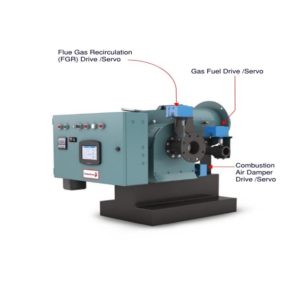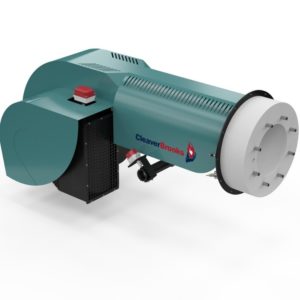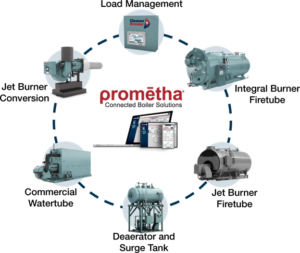In this blog we cover general steps when faced with the decision to replace older outdated burners vs. a complete boiler replacement.
Whether your consideration to replace comes from a poorly functioning burner, the drive to become more environmentally friendly, improve performance & reliability, increase efficiency or a combination of factors, the following will provide guidance to help achieve your goals.
1. Verify your boiler’s condition and expected longevity.
-
- Perform internal fireside and waterside inspection to ensure vessel integrity and insulating materials are in good condition and repair/ replace components, as necessary.
- Consider boiler life expectancy and costs associated with reaching boiler end date with respect to other ancillaries that may need replacement.
- Upon review of results, determine if proceeding to step 2 is viable.
2. Employ a reputable burner supplier & installer to establish the budget.
-
- Determine if your burner project will require an “air permit” through Michigan DEQ/EGLE, (Department of Environment, Great Lakes & Energy), AQD (Air Quality Division).
- Select burner type to match goals. Fuel type, standard or low NOx, Single-Point- Linkage vs. Parallel Position, Linkage-less, Burner firing rate control. (See illustrations below)
- Select emission level required or expected. Generally, in SE Lower Michigan under Boiler MACT, below 10 MMBTU/Hr. burning natural gas will expect new burners to be 30 PPM NOx or less emission level.
- Determine if emission level be achieved will be via FGR (flue gas recirculation) or by internal burner design w/o FGR. Installed cost & blower horsepower (operating costs) normally affect this decision.
- Establish burner turndown required. Most conventional replacement burners today depending upon capacity and fuel burned, will deliver anywhere from 5 to 10:1 turndown. Verify offering with customer expectation with all associated fuel(s) to be used.
- Consider VFD (variable frequency drive) as part of control strategy for better combustion control and electrical energy savings. Weigh added cost vs. potential payback. VFD does not make sense for all size & type projects. Payback using VFD on small burner/boiler used for comfort heat only may not make sense.
- Combustion and Firing rate controls: Consider overall control strategy to compliment chosen burner using technology that best fits your plant’s operation and budget. Discuss & decide flame safeguard & scanner type, load demand and duty cycle with firing rate control from main or “master” panel (multiple boilers/burners), diagnostics, connectivity to remote device, phone app or BMS, alarm options, implementation of oxygen trim system, reporting and recording options via SCADA, PC, HMI screen size (if required) & boiler level control upgrades.
* See “prométha” connected solutions below for example.
-
- Confirm boiler/burner “altitude” at installed location. Elevations above 2000 ft. ASL warrant review by an application engineer to confirm fan size or necessity to de-rate burner output affecting rated performance.
- Consider new burner’s sound pressure levels (dbA at “X” Hz) at all firing rates to verify acceptability.
- Provide engineering documentation to confirm burner fit and operation with existing boiler’s flange mount, combustion chamber and gas passage area, through stack, breeching, economizer, or other pressure drops to outlet. No excessive back pressure or adverse combustion conditions should arise with normal burner operation at rated capacities. Larger and Industrial boiler/burners with stringent NOx requirements and/or larger furnace areas may require computational fluid dynamic (CFD) analysis to best match new burner with boiler.
- Burner supplier should provide an “engineered” stack loss calculation for proper verification of expected and acceptable draft conditions.
3. Review budgetary or firm proposed price.
-
- Determine if ROI fits within boiler’s expected life.
- Consider potential for unforeseen repairs or modifications.
- Secure funding.
4. Proceed with investigation of required details.
-
- Confirm fuel(s) to be used.
- Verify fuel delivery system’s integrity including piping, fuel regulation, isolation valves, vents, strainers etc., are operable and up to current code requirements. Repair/replace, as necessary.
- Confirm gas pressure required at the inlet to the burner and at inlet to fuel train is available and deliverable to fuel train inlet with existing transmission piping.
- Required electrical service is available and costs include any service upgrades needed to implement new burner electrical feed, low and high voltage along with any required BMS interface, connecting testing and upgrades to existing systems.
- Consider if UPS/Surge suppressor will be expected or required. Strongly suggest using UPS/Surge suppressor if using PLC type controls.
- If using IP protocols, verify via coordinated effort with installer, controls contractor and owner for clean integration between new and existing control connections.
- If using a stand-alone internet connection for remote boiler/burner monitoring, such as “prométha” shown below; confirm all hardware such as modems, power supply, software, mounting, wiring and set-up are included.
- Confirm installer has included costs for mechanical/electrical and other permits as required.
- Obtain formal quotation with firm or “not-to-exceed” pricing and agree on T’s & C’s along with labor & material warranty terms.
- Verify lead times and project completion expectations.
- Receive copy of all documentation, including but not limited to, permit application(s), Insurance, and installer’s License.
5. Once formal purchase order has been given and prior to release for production:
-
- Receive and review submittal information with project team confirming fit, layout, coordination, and sequence of installation.
- Confirm fuel train layout & inlet location is acceptable and make final changes if needed.
- Determine drop-ship location, equipment receipt process and materials protection prior to installation.
- Review all owner safety requirements and provisions, house-keeping measures and site logistics with team and perform sign-off process.
6. Project Completion:
-
- Review entire installation for proper completion, including wiring continuity checks, burner and controls mounting, fuel delivery system leak testing and all other (FGR) piping, gaskets, and seals as necessary.
- Test, check & start new burner, combustion and firing rate controls and other new products as part of project.
- Submit written documentation of all test procedures, combustion reports and CSD-1 test reports as required.,
- Call local jurisdiction for inspection. Note: certain jurisdictions may require inspection prior to startup. Verify first.
- Perform “witness testing” with owner and obtain sign off.
- Perform operator training, review O & M manuals and review maintenance procedures with owner/operator.
- Review spare parts (if needed) and purchase points.
- Sign off project completion documentation “as-built” drawings and close out project.Note: The above will vary with project, however, should provide a general process for your BURNER REPLACEMENT consideration.
See Illustrations to assist in understanding basic options: A Typical Standard burner single point positioning / jackshaft control
A Typical Standard burner single point positioning / jackshaft control

Typical Burner with Parallel Position Controls

LOW NOx Burner / NO FGR Required with Parallel Position Controls
“prométha” Connected Boiler Solutions:
-
- Load Management
- Boiler/Burner Diagnostics
- Deaerator–Surge Tank Feedwater System Management

A variety of reliable connected solutions are available for your consideration.
Please contact our sales team below.
D.J. Conley has supplied quality Cleaver-Brooks ProFire®/ Industrial Combustion retro-fit burners to the SE Michigan boiler market for nearly 50 years. Our commitment to quality assures your satisfaction. We regularly partner with our contracting community to provide turn-key installations. Give us a call to assist in your next burner project or for a free evaluation of your current boiler/burner system!
Contact us at (248) 589-8220 and ask for Aftermarket Sales or email: aftermarket@djconley.com
For more information, go to www.djconley.com click on “Products”, then scroll to “Boiler Burners”.
Author: M. Conley / D. J. Conley Associates Inc. 1974 – present.
Information in this blog is being furnished by D. J. Conley Associates Inc. and by those having numerous years of experience in design, installation, and application with generation of heating and process steam and hot water products and services. This information along with supplemental data obtained from a variety of sources is for the beneficial use of its audience only. We cannot be held liable for the application or misapplication of products or methods associated with this data which may cause unfavorable issues or harmful outcomes since there are many circumstances beyond our control at play in every individual system. You are welcome to contact us in the event questions should arise.
